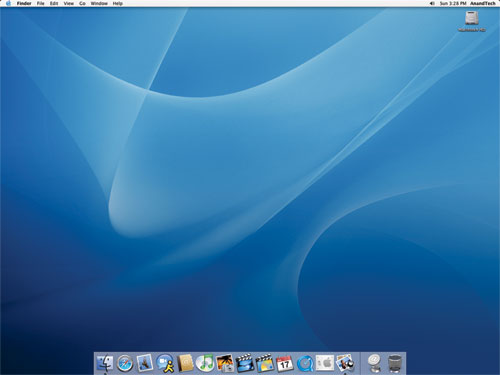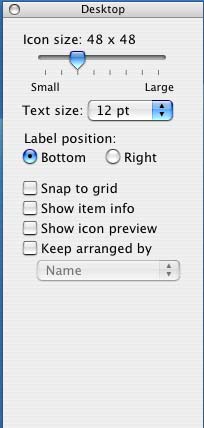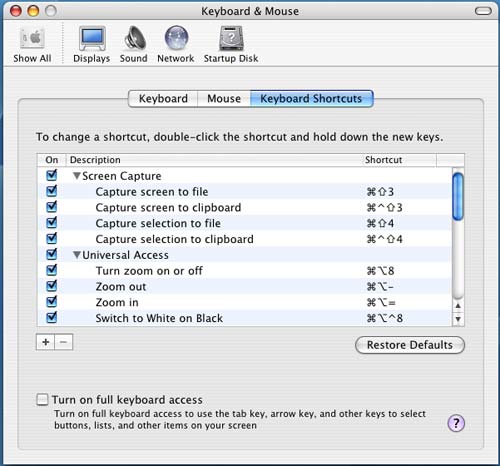A Month with a Mac: A Die-Hard PC User's Perspective
by Anand Lal Shimpi on October 8, 2004 12:05 AM EST- Posted in
- Mac
Finding my way around Finder
The OS X desktop is clearly different from what I was used to under XP. For starters, all of the icons have been moved to the right side of the screen; and where I was used to seeing a taskbar, there was this little translucent "dock" with a bunch of icons in it.
The OS X desktop and features, such as icon size, dock size and animations, are easily customizable.
Click to enlarge.
Under Windows, there is Explorer. It is the application that not only exists as a way of browsing your file system, but also as the "desktop" itself; the OS X equivalent? Finder. I don't think that I have to point out the similarity in the names. Yes, one company copied (or poked fun at) another.
My first reaction was that the icons on the desktop were far too large; indeed, they are, if you put them on a Windows desktop - but for some reason, they end up looking strange if you make them smaller. One of the biggest features of OS X is the ability to customize just about every aspect of the OS; I didn't like the size of the icons at first, so I simply changed the icon size through the "view options" menu. Although it's easy to talk about now, I had to ask how to do it online before I ever discovered the option - also the case with the majority of OS X, most of the power and customization of the OS remains hidden. I quickly realized that although Apple had targeted the entry level computer user with the interface of OS X, the OS was far more tailored to the power user in my opinion.

Where to start? Customization is much more possible (and easy to do) under OS X than any variant of Windows that I have ever encountered. Icon sizes are just the beginning; through the view options menu alone, you can change the positioning of the labels on the icons, the text size as well as the normal array of Windows options. And any changes you make here occur in real time - no clicking "OK" or "Apply". Just check a box and it happens instantaneously; and uncheck it, and everything goes back to normal. It's a small thing, but as I soon found out, much of OS X's appeal to me came in tiny gems like this.
The other thing to point out, which is quite possibly the biggest draw to OS X for me, is the fact that just about everything under OS X has a keyboard shortcut associated with it. I've found that if you got your start with PCs in the DOS days, then you end up being much more of a keyboard junkie than someone who is reliant on the mouse. I use the mouse when I have to, but when it's quicker to use the keyboard, I feel much more comfortable firing off a few keystroke combinations to get my point across. If you are anything like me in that respect, then OS X will be your playground.
I can't possibly list all of the keystroke combinations that I use on a daily basis, but there are quite a few. For example, I am a big "ALT-TAB"-er in Windows, but ALT-TAB is only really useful for switching applications, not closing them. The ALT-TAB equivalent under OS X, Command-TAB (the Command key is positioned where you'd expect ALT to be, so it works out fine), works similarly, but here's the catch - hit "Q" while you've selected an application and it will quit automatically. Nice, but nothing major right?
Want to minimize a window? Command-M will take care of that. Want to hide an application without minimizing it? Command-H. Hidden windows will automatically move to the end of the Command-TAB list, so you don't switch to them after you've hidden them.
Want to open a new Finder window? Command-N. Want to create a new folder on your drive? Shift-Command-N. I've always wanted to be able to create new folders in Explorer without using the mouse. OS X was a dream come true in that respect.
OS X will even let you define your own keyboard shortcuts for any application through the keyboard preferences panel:

Not impressed? Not a keyboard junkie? Then Finder is just as capable and as usable as Explorer. No big win for Apple there, but maybe a draw. For me, the little things are what intrigued me, but I'll admit - not everyone is as easily amused!
There is one aspect of the keyboard shortcut support that OS X does fall behind on, and that is support for keyboard shortcuts in dialog boxes. In some dialog boxes, hitting Command and the letter of the option you want to select will work, but in others, it will not. Furthermore, finding out the correct key to hit to select the option that you want is most definitely a guessing game, as there are no underlined characters or anything indicating what key to hit. Given OS X's strong support for keyboard shortcuts, this shortcoming (no pun intended) is puzzling.










215 Comments
View All Comments
dmr9748 - Saturday, October 9, 2004 - link
You again failed to provide proof. The first site is a bunch of pictures. I have been to that campus and have met some of the people in those pictures. This is how funding works, if someone gives you money and says that you can only spend it on x, are you going to give up that funding? NONow, let's take a look at comparing 2 exact same items. They will never perform the same. Do you know why? There is about a billion reasons why. The mos striaght and to the point example is the movie "Timeline." Look at post #97.
The only one that came close to proving me wrong was the linuxsinder.com post. Problem is, he doesnt tell me what vendor he is going to except for dell and the things is I just did a price comparison on both those items. I have given the direct links to the vendors.
With some of the last links you posted, go back to post #112.
rxmz - Saturday, October 9, 2004 - link
Azkman has already answered #112 very well, but just a quick look at the Dell shows it only has 2 HD bays, neither front accessible nor hot swappable. It's not 64-bit, and doesn't have a 1GHz front-side bus. I'd guess there are other reasons it's not in the same comparison class as the Xserve G5, but I think that's plenty already.azkman - Saturday, October 9, 2004 - link
Hard evidence for #112 (none from pro-apple sources):http://www.tcf.vt.edu/systemX.html
http://www.colsa.com/cover_page/news_front/news_de...
http://www.top500.org/list/2003/11/
http://www.linuxinsider.com/story/36120.html
http://www.linuxinsider.com/story/36964.html
http://www.roanoke.com/news/roanoke%5C6133.html
http://www.pcmag.com/review/0%2C2491%2Cs%3D1564&am...
http://www.pcmag.com/article2/0,1759,1369037,00.as...
Specs do not equal performance. I haven't heard of any Dell supercomputers being built at breakthrough prices. I'd believe the jugdement and results of VT and the US Army over an arbitrary price comparison any day.
dmr9748 - Saturday, October 9, 2004 - link
I just did a price comparison of my own between an xserve and a dell server.Here is the xserve for $2898.99
http://www.ctistore.com/Merchant2/merchant.mvc?Scr...
I priced a rackmount server with the same specs on dell.com for $2021
http://configure.us.dell.com/dellstore/config.aspx...
#95 Don't post an article that explains one system and then say it is more cost effective for what you get compared to another system when the article doesn't even mention a price for the system they are describing. Do not attack my post unless you have some hard evidence.
kmmatney - Saturday, October 9, 2004 - link
reading all these comments from (most) the mac users that have posted makes me want a mac less and less.-- I second that one. $2500 for a computer with no monitor and a crap video card. That's the "uncomfortable" part to me.
victorpanlilio - Saturday, October 9, 2004 - link
#109 dextrous wrote: reading all these comments from (most) the mac users that have posted makes me want a mac less and less.Care to elaborate? Using this same sort of reasoning, then all of the positive comments a people might happen to make about their own country should dissuade foreign tourists from visiting. And of course, such people should not object if their country is portrayed in a bad light by foreigners who know little or nothing about the country. What's more, the foreigners are afraid that a learning experience might actually force them to rethink their prejudices. To bring this discussion back on topic, what Anand has done is the equivalent of visiting a foreign country, sampling its cuisine, experiencing something of its culture, and so on. His "travelogue" describes his impressions. The forum participants chime in with their own dispatches from the field -- and those who have visited and perhaps lived in the foreign country for some time are in a better position to comment knowledgeably.
dextrous - Saturday, October 9, 2004 - link
reading all these comments from (most) the mac users that have posted makes me want a mac less and less.victorpanlilio - Saturday, October 9, 2004 - link
In #107 topcat903 wrote: "Basically, this article describes the "uncomfortable" feeling we get when we switch to something we are not used to."And if that's all it was, then the remedy is simple -- learn. But in the article, as well as in the comments, uncalled-for remarks about price etc. detract from the overall message that it is quite possible for a diehard but open-minded Windows PC user to discover genuinely superior things about MacOS X even without delving into applications that make best use of the platform.
topcat903 - Saturday, October 9, 2004 - link
I don't think this article was to compare which system (hardware or software wise) is better. It was written to describe the "experience" one would feel when switching to another OS (heck, the same thing could be said about switching girlfriends or boyfriends).I started my computing days using the Apple IIe, then the first Mac...eventually I switched to the Windows platform, and recently since my wife got an iBook, I had to switch back to OS X.
Basically, this article describles the "uncomfortable" feeling we get when we switch to something we are not used to...A feeling I experienced many times over. All the speed, power, and storage of a system could mean nothing to me if I don't know all the ins and outs of what I'm using to get what I needed done.
Overall, the article was a good and interesting read...just wish there was more on the audio/video apps (where Apple truly excel), however I assume it's not what the author's primary use of the G5...but hopefully a start towards many more articles.
rxmz - Saturday, October 9, 2004 - link
A quick FYI semi-related to Mac OS X scroll speed. Clicking in the empty area of a scroll bar jumps by a page, but clicking while holding down the "option" key jumps straight to that point (reversible via a system preference). This comes in very handy for long documents (or file listings), when you know about where you're trying to go.As an aside, the only app I have seen where this does NOT work is MS Word....